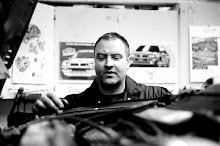Andrew looked high and a low for a really good Evo 1 to do a restoration project on, but sadly settled for a Winner red.
He then proceeded to pull it to bits and is reconditioning everything which could be and replacing everything which couldn't, we are talking about a full-on nut and bolt restoration here, every step and every part has been methodically logged, pictured and written about and lot of people eagerly await the results of his years of hard work.
All results below were taken at 10" of depression.
First up on the flowbench was a mildly reprofiled throttle body, it looked really nice and I would have put money on it giving 2 or 3cfm extra, result? Zero improvement over standard.
Well it could only get better and next up was a bit more interesting: An OE intercooler with the end tanks removed and a new more modern core welded inbetween them. The exit/entry pipes had been mildly re-profiled and polished, the quality of welding was superb and we counted less tubes than the OE 'cooler meaning it had larger section ones fitted. Looking into the core you could see it was a more aerodynamically friendly affair, but still tube and fin construction (see earlier intercooler article).

On the bench the OE intercooler flowed 153cfm.
The re-cored one flowed 165cfm.
So not a bad result for a simple core change and a bit of cleaning up, I think they could have got more by changing to a bar & plate type, or at least, it would have been interesting to test one anyhow. As outlined before if you want more power then get more airflow by trading up to larger section core, but if you want to keep your integrale looking standard whilst gaining a bit and lightly modernising it then it's not a bad mod.
Andrew then brought in a head he had done by someone without a flowbench so had no figures for it. It had been very tidily done, no major changes to the port geometry or valve and seat angles, just some rounding off of the short-side-radius and knife edging on the port splitter.

A stock head flows 137cfm
And his was up to 155cfm

So again a good modest improvement, high CFM figures aren't everything and I didn't have the time to do any valve-in tests.
We tested an OE cast iron log manifold on an umodified head V Andrews tubular item:


As you can see, nothing really unexpected, but interesting to see nonetheless. Looking closer at the figures, at least the tubulars best and worst flowing headers are within 10cfm of each other whilst the OE log has a much larger 18cfm difference.
This was supposed to be just a factual post on what we found out from the items tested, but lets wander off for a moment and look a bit closer at the usual manifold debate questions.
Are you going to see a non flow loss ex'manifold on an integrale which keeps the turbo in its original position? Well I think you're going to struggle! I'm saying this not only from what we have found here, but also because we have a life size model along with modelling kit in the workshop which we are making our own on so I know how difficult (impossible?) it is to create the perfect manifold.
Do you really need equal length tubes? Yes. Look at the tubular one on test, the shortest pipe has the worst CFM figure, it has this because of the number of bends and restrictions in it, so what if we build a manifold purely based on equal flow rates for all four pipes?
What is the point in an equal length manifold if the flow figures are all over the place?
Food for thought and open to discussion, but the answer for me would be equal length and equal flow.
Another widely debated topic is whether the integrale 16v inlet manifold is better than that of the Fiat Coupe, many people claim it is so we did a back to back test and found no difference between the two at all. Both showed a 36cfm loss when bolted to a head flowing 168cfm on cylinder No.1.






